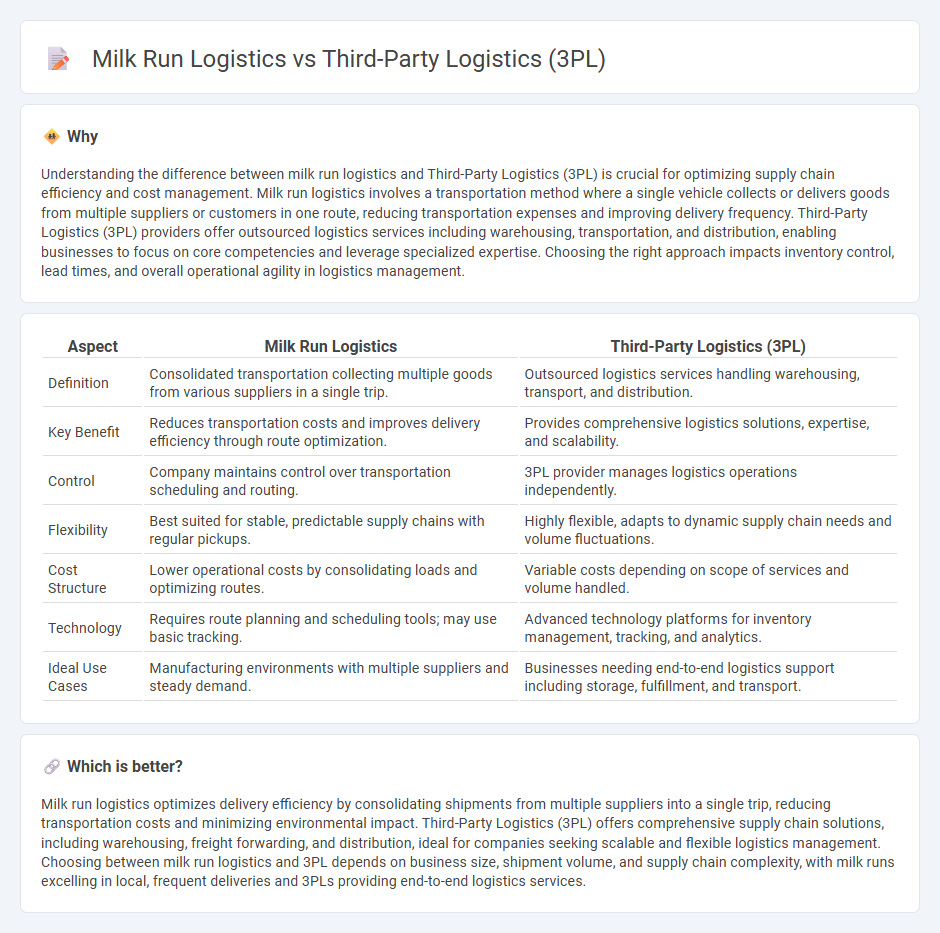
Milk run logistics optimizes supply chain efficiency by consolidating multiple deliveries into a single route, reducing transportation costs and minimizing environmental impact. Third-Party Logistics (3PL) providers offer comprehensive outsourcing solutions, handling warehousing, distribution, and freight management to enhance operational flexibility. Explore the differences between milk run logistics and 3PL to determine the best strategy for your supply chain needs.
Why it is important
Understanding the difference between milk run logistics and Third-Party Logistics (3PL) is crucial for optimizing supply chain efficiency and cost management. Milk run logistics involves a transportation method where a single vehicle collects or delivers goods from multiple suppliers or customers in one route, reducing transportation expenses and improving delivery frequency. Third-Party Logistics (3PL) providers offer outsourced logistics services including warehousing, transportation, and distribution, enabling businesses to focus on core competencies and leverage specialized expertise. Choosing the right approach impacts inventory control, lead times, and overall operational agility in logistics management.
Comparison Table
| Aspect | Milk Run Logistics | Third-Party Logistics (3PL) |
|---|---|---|
| Definition | Consolidated transportation collecting multiple goods from various suppliers in a single trip. | Outsourced logistics services handling warehousing, transport, and distribution. |
| Key Benefit | Reduces transportation costs and improves delivery efficiency through route optimization. | Provides comprehensive logistics solutions, expertise, and scalability. |
| Control | Company maintains control over transportation scheduling and routing. | 3PL provider manages logistics operations independently. |
| Flexibility | Best suited for stable, predictable supply chains with regular pickups. | Highly flexible, adapts to dynamic supply chain needs and volume fluctuations. |
| Cost Structure | Lower operational costs by consolidating loads and optimizing routes. | Variable costs depending on scope of services and volume handled. |
| Technology | Requires route planning and scheduling tools; may use basic tracking. | Advanced technology platforms for inventory management, tracking, and analytics. |
| Ideal Use Cases | Manufacturing environments with multiple suppliers and steady demand. | Businesses needing end-to-end logistics support including storage, fulfillment, and transport. |
Which is better?
Milk run logistics optimizes delivery efficiency by consolidating shipments from multiple suppliers into a single trip, reducing transportation costs and minimizing environmental impact. Third-Party Logistics (3PL) offers comprehensive supply chain solutions, including warehousing, freight forwarding, and distribution, ideal for companies seeking scalable and flexible logistics management. Choosing between milk run logistics and 3PL depends on business size, shipment volume, and supply chain complexity, with milk runs excelling in local, frequent deliveries and 3PLs providing end-to-end logistics services.
Connection
Milk run logistics optimizes material flow by consolidating shipments from multiple suppliers into a single route, reducing transportation costs and emissions. Third-Party Logistics (3PL) providers specialize in managing these complex, multi-stop routes efficiently, leveraging their network and technology to enhance supply chain visibility and reliability. This synergy between milk run logistics and 3PL services results in streamlined operations, improved delivery times, and cost savings across the supply chain.
Key Terms
Outsourcing
Third-Party Logistics (3PL) outsourcing offers comprehensive supply chain management services including warehousing, transportation, and inventory control, enabling businesses to leverage expert solutions and reduce operational costs. Milk run logistics outsourcing emphasizes consolidated, scheduled pickups and deliveries along a fixed route, optimizing load efficiency, minimizing transportation expenses, and reducing carbon footprint. Explore the strategic advantages and detailed applications of 3PL and milk run outsourcing to enhance your logistics operations.
Consolidation
Third-Party Logistics (3PL) providers manage the consolidation of shipments by leveraging extensive networks and technology to optimize routes and reduce costs, handling multiple clients' goods in a single delivery process. Milk run logistics specifically focuses on the systematic collection and delivery of small shipments along a fixed route, enhancing consolidation efficiency by minimizing transportation miles and improving load utilization. Explore how strategic consolidation through 3PL and milk run logistics can streamline supply chain operations for your business.
Route Optimization
Third-party logistics (3PL) providers utilize advanced route optimization algorithms to enhance delivery efficiency by consolidating shipments and minimizing travel distances across diverse clients. Milk run logistics focuses on optimizing fixed routes for frequent pickups and deliveries within a supply chain, reducing transportation costs and inventory levels by synchronizing supplier schedules. Explore the key differences in route optimization strategies between 3PL and milk run logistics to improve your supply chain management.
Source and External Links
What is 3PL (third-party logistics)? - This webpage defines 3PL as a provider offering outsourced logistics services, including procurement, fulfillment, and supply chain management.
What is a 3PL? - This webpage explains that 3PLs are businesses providing services like warehousing, shipping, and inventory management to optimize supply chain operations.
3PLs, Explained: The Complete Guide to Third-Party Logistics - This guide provides an overview of 3PLs as service providers handling various supply chain functions, including transportation, storage, and shipping.
 dowidth.com
dowidth.com